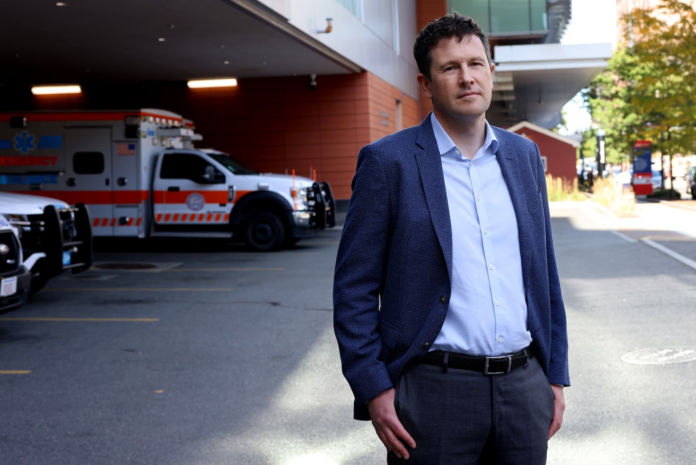Now comes the hard part: making sure the troubled hospitals it rescued can survive, and serve their patients, in the new alignment.
That day, they became employees of BMC, the state’s largest safety net hospital — now by a long shot. Long a health care anchor in the heart of Boston, the system has emerged from the Steward ashes with more than twice as many hospital beds and a regional footprint, the most essential player in the state’s rescue of Steward’s tottering hospitals.
Dr. Alastair Bell, chief executive of Boston Medical Center, got up early on Tuesday, the first day of the post-Steward era in Massachusetts. He drove to Brockton to greet caregivers as they arrived at Good Samaritan Medical Center. In the afternoon, he was back in Boston, welcoming staffers at St. Elizabeth’s Medical Center as upbeat music played and managers handed out donuts in the lobby.
Advertisement
BMC’s chief has no illusions about the monumental challenge ahead. Both of the hospitals it acquired had been weakened by the departure of patients, doctors, and nurses as for-profit Steward Health Care stumbled into bankruptcy after failing to make repairs or pay vendors for years.
“What we’re aiming for here is short-term stability and long-term sustainability,” the 48-year-old Bell said in an interview. “We’ve been very focused on day one priorities … patient care and quality, and making sure that these organizations have the supplies they need.”
Other immediate challenges for Bell and his management team include integrating thousands of new employees and getting to know clinical leaders at St. Elizabeth’s and Good Samaritan. BMC will seek to move quickly on repairs on the long-neglected properties, fixing leaky roofs and broken elevators, Bell said, but more expensive capital improvements will take longer.
“Some of this is not terribly complex stuff,” said Bell, who took the top job at BMC in June 2023. “If you don’t pay the elevator vendor when the elevators go out, which they do, then no one comes to fix them.”
For all of the excitement at BMC’s expansion and its vision to better serve patients in Brighton and Brockton, there is a crush of unglamorous work that must play out in the background if the hospitals are to pull through.
Advertisement
Dr. Alastair Bell, chief executive of Boston Medical Center, greets staff at Good Samaritan Medical Center in Brockton on Oct. 1. Boston Medical Center acquired the hospital from Steward Health Care. Jonathan Wiggs/Globe Staff
Integration of the hospitals, from technology platforms to patient referrals, will take extensive planning. Dr. Ravin Davidoff, executive medical director and clinical Integration lead for BMC, will work with colleagues at St. Elizabeth’s and Good Samaritan — hospitals known in the medical world as “St. E’s” and “Good Sam” — some of whom have sent trauma and acute stroke patients to BMC in the past.
“We believe strongly there will be opportunities for us to learn from them, for them to learn from us, and then together for us to think about how we can serve the most vulnerable populations,” Davidoff said.
BMC is one of three health systems in Massachusetts and Rhode Island that acquired six Steward hospitals on Sept. 30, converting them back to nonprofits. Lifespan Health System of Providence purchased St. Anne’s Hospital in Fall River and Morton Hospital of Taunton, while Lawrence General Hospital bought Holy Family Hospital in Methuen and Haverhill.
All of those hospitals serve low-income and working-class communities where the health needs of patients are often compounded by worries about finding housing, losing jobs, and food insecurity.
“People will come in worried that they can’t make rent, there’s some sort of difficult situation at home, they’re worried about their kids and their schools,” Bell said. “Understanding how to engage and work with people on their health with that broader array of concerns is a real skill set.”
A view of Good Samaritan Medical Center in Brockton. Jonathan Wiggs/Globe Staff
In some ways, BMC is an unlikely rescuer for distressed hospitals. The system has had its own financial struggles, though it has stabilized its balance sheet in recent years. BMC Health System, which includes its expanding health insurance business, reported $6 billion in operating revenue and $3.1 million in operating income in 2023.
Advertisement
Now the system, with 511 beds, will be taking over the 224-bed Good Samaritan and St. Elizabeth’s, which has 291 beds, more than doubling its capacity. BMC’s workforce will increase from about 10,000 to 15,000 employees.
BMC, formed through the 1996 merger of Boston City Hospital and University Hospital, already receives more state and federal aid through the MassHealth and Medicare programs than any other provider in the state. About 70 percent of its patients are people of color, more than three quarters insured by public health programs.
Through its health plan, WellSense, the state’s largest Medicaid managed care plan, and its teaching affiliation with Boston University School of Medicine, it is recognized as a pioneer in treating underserved communities. It also partners with community health centers in Boston neighborhoods, such as Roxbury, Dorchester, and Mattapan.
Rev. Willie Bodrick II, senior pastor at Twelfth Baptist Church in Roxbury, who joined the BMC board last year, said the hospital has deep community ties. It sponsored vaccination clinics at his church and others during the pandemic. Last week, it hosted a “returning citizens” roundtable at his church for formerly incarcerated residents.
“BMC is the health care center that is there for those who are struggling with so many issues, whether it be health issues or even sexual abuse issues,” said Bodrick, whose wife is an attending physician at BMC. “It thinks of itself as more than just a hospital. It’s a community partner.”
Indeed, its mission of providing quality and “culturally relevant” care to an urban population could make it a natural fit for St. Elizabeth’s and Good Samaritan. While those hospitals serve somewhat older populations and have more commercially insured patients, both also rely heavily on government payers. St. Elizabeth’s, formerly the Steward flagship in Massachusetts, is also a BU teaching hospital.
Advertisement
By taking over operations at those hospitals, BMC will be bringing its mission to a larger stage, Bell said. “I feel like we have some form of an implicit contract with the state,” he said. “We step forward in times of need. It was very important for these organizations to stay open.”
BMC has been battle-tested in recent years. It worked with neighborhood health centers to boost trust in — and access to — Covid vaccines in Black and Latino communities during the pandemic. And it provided temporary overnight shelter to migrant families last year before ending the practice, and referring them to other facilities, when it determined the influx was disrupting hospital operations.
A view of Boston Medical Center. Jessica Rinaldi/Globe Staff
Kate Walsh, the state’s secretary of health and human services, who led the effort to save as many Steward hospitals as possible, is quite familiar with BMC’s mission. She was BMC’s chief executive from 2010 to 2023, serving as a mentor to Bell, a Scottish-born former McKinsey health care consultant she hired in 2012. Bell replaced Walsh when she joined Governor Maura Healey’s administration last year.
As it becomes a larger regional player, Walsh said, BMC will be “filling in pieces of a role they’ve already assumed” in serving vulnerable communities. She noted that BMC’s health plan already insures many MassHealth patients at St. Elizabeth’s and Good Samaritan, and BMC already operates a behavioral health facility in Brockton.
“Boston Medical Center is not just the hospital on the corner of Albany Street and Harrison Avenue [in Boston],” Walsh said. “It is a system of care and it is a health plan that has lives in the Brockton area and other parts of Boston.”
Advertisement
BMC’s expanded role will be supported by state funding. The Healey administration will spend $417 million over the next three years to help bankroll the transition at five of the hospitals that have changed hands. It hasn’t disclosed how much funding will go to St. Elizabeth’s.
The administration last week seized the St. Elizabeth’s property from a private landlord by eminent domain, but a court is expected to determine how much it will ultimately pay for the land and buildings. In all, the rescue of the Steward hospitals is expected to cost the state, the US government, and other hospitals as much as $700 million. A payout to the St. Elizabeth’s landowner could add to that total.
The Healey administration, which seized St. Elizabeth’s Medical Center from a private landlord by eminent domain, hasn’t disclosed how much funding will go to the hospital. Suzanne Kreiter/Globe Staff
State backing is nothing new for BMC. “BMC, more than anybody else, has been back-stopped by the state” through generous MassHealth reimbursements over the years, said Paul Hattis, a fellow at the Lown Institute, a think tank.
“For the next three years, there’s a lot of uncertainty about how much more [money] they’ll need,” Hattis said. “Longer term, there’s the promise of a healthier BMC financially with a more diverse revenue mix and more commercially insured patients.”
Bell, for his part, won’t specify how much funding the state has committed to the BMC transition, saying only that “the state has stepped forward with very substantial amounts of support.”
In talks with state officials, he said, “our starting point was shared alarm at the prospect of multiple [hospitals] across Eastern Massachusetts closing” and its impact on public health and BMC’s own operations. Two other Steward facilities, Carney Hospital in Dorchester and Nashoba Valley Medical Center in Ayer, were shuttered on Aug. 31, adding to the burden on other hospitals in the state.
Bell, who grew up in Gattonside, a village of a few hundred people in rural southeast Scotland, thinks he and his team at BMC may be well suited to resuscitate and revitalize the Steward hospitals.
“I come out of a country that believes pretty robustly in social supports,” he said. “So I definitely bring an innate set of values that fit well with what BMC’s trying to do.”
Stephanie Barros, left, a mental health associate at Good Samaritan Medical Center in Brockton, shook hands with Dr. Alastair Bell, right, chief executive of Boston Medical Center, which acquired the hospital from Steward Health Care. Jonathan Wiggs/Globe Staff
Robert Weisman can be reached at robert.weisman@globe.com.



